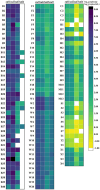Development and application of a highly sensitive quadruple droplet digital PCR method for simultaneous quantification of sulfonamide resistance genes
- PMID: 40469733
- PMCID: PMC12133762
- DOI: 10.3389/fmicb.2025.1612740
Development and application of a highly sensitive quadruple droplet digital PCR method for simultaneous quantification of sulfonamide resistance genes
Abstract
Sulfonamide resistance genes (sul genes) have a high detection rate and strong transmissibility. Therefore, there is an urgent need to develop more efficient detection methods to enhance the monitoring of sul genes. Current analytical methods are insufficient for the simultaneous and accurate quantification of all sulfonamides resistance genes. To overcome this limitation, a quadruple method was established by integrating droplet digital PCR (ddPCR) with the ratio-based probe-mixing strategy, achieving sensitive detection of sul1, sul2, sul3, and sul4 genes in diverse matrices. Correspondingly, the primers and probes of sul genes were meticulously designed and rigorously validated, and the critical parameters for ddPCR such as annealing temperature, concentrations of primers and probes were systematically optimized. As a results, the quadruple ddPCR method demonstrates excellent sensitivity with limits of detection (LOD) ranging from 3.98 to 6.16 copies/reaction, and good repeatability (coefficient of variation <25%), adequately meeting the requirement for accurate sul genes quantification. Furthermore, this new method was applied across 115 diverse samples, including human feces, animal-derived foods, sewage and surface water, achieving positive rates of 100% for sul1, 99.13% for sul2, 93.91% for sul3, and 68.70% for sul4, with sul genes concentration ranging from non-detection to 2.14 × 109 copies/g. In summary, the developed quadruple ddPCR method has potential to serve as an efficient and sensitive tool for monitoring sul genes.
Keywords: animal-derived foods; droplet digital PCR; feces; quadruple detection; sewage; sulfonamide resistance genes; surface waters.
Copyright © 2025 Yin, Nie, Tian, Duan, Wu, Xu, Guo and Wang.
Conflict of interest statement
The authors declare that the research was conducted in the absence of any commercial or financial relationships that could be construed as a potential conflict of interest.
Figures








Similar articles
-
Establishment of a Multiplex Loop-Mediated Isothermal Amplification Method for Rapid Detection of Sulfonamide Resistance Genes (sul1, sul2, sul3) in Clinical Enterobacteriaceae Isolates from Poultry.Foodborne Pathog Dis. 2018 Jul;15(7):413-419. doi: 10.1089/fpd.2017.2410. Epub 2018 Apr 30. Foodborne Pathog Dis. 2018. PMID: 29708802
-
Prevalence and characterization of plasmids carrying sulfonamide resistance genes among Escherichia coli from pigs, pig carcasses and human.Acta Vet Scand. 2010 Jul 30;52(1):47. doi: 10.1186/1751-0147-52-47. Acta Vet Scand. 2010. PMID: 20670455 Free PMC article.
-
Diverse Mobile Genetic Elements and Conjugal Transferability of Sulfonamide Resistance Genes (sul1, sul2, and sul3) in Escherichia coli Isolates From Penaeus vannamei and Pork From Large Markets in Zhejiang, China.Front Microbiol. 2019 Aug 2;10:1787. doi: 10.3389/fmicb.2019.01787. eCollection 2019. Front Microbiol. 2019. PMID: 31428076 Free PMC article.
-
Development and evaluation of a Luminex xTAG assay for sulfonamide resistance genes in Escherichia coli and Salmonella isolates.Mol Cell Probes. 2020 Feb;49:101476. doi: 10.1016/j.mcp.2019.101476. Epub 2019 Oct 31. Mol Cell Probes. 2020. PMID: 31678631
-
Strategy to develop and validate digital droplet PCR methods for global antimicrobial resistance wastewater surveillance.Water Environ Res. 2024 Nov;96(11):e11145. doi: 10.1002/wer.11145. Water Environ Res. 2024. PMID: 39467614
References
-
- Adelowo O. O., Helbig T., Knecht C., Reincke F., Mäusezahl I., Müller J. A. (2018). High abundances of class 1 integrase and sulfonamide resistance genes, and characterisation of class 1 integron gene cassettes in four urban wetlands in Nigeria. PLoS One 13:e0208269. doi: 10.1371/journal.pone.0208269, PMID: - DOI - PMC - PubMed
-
- Branchet P., Ariza Castro N., Fenet H., Gomez E., Courant F., Sebag D., et al. . (2019). Anthropic impacts on sub-Saharan urban water resources through their pharmaceutical contamination (Yaoundé, Center Region, Cameroon). Sci. Total Environ. 660, 886–898. doi: 10.1016/j.scitotenv.2018.12.256, PMID: - DOI - PubMed
-
- Cavé L., Brothier E., Abrouk D., Bouda P. S., Hien E., Nazaret S. (2016). Efficiency and sensitivity of the digital droplet PCR for the quantification of antibiotic resistance genes in soils and organic residues. Appl. Microbiol. Biotechnol. 100, 10597–10608. doi: 10.1007/s00253-016-7950-5, PMID: - DOI - PubMed
-
- Ciesielski M., Blackwood D., Clerkin T., Gonzalez R., Thompson H., Larson A., et al. . (2021). Assessing sensitivity and reproducibility of RT-ddPCR and RT-qPCR for the quantification of SARS-CoV-2 in wastewater. J. Virol. Methods 297:114230. doi: 10.1016/j.jviromet.2021.114230, PMID: - DOI - PMC - PubMed
LinkOut - more resources
Full Text Sources
Research Materials

